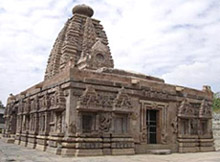 Location: Situated on the confluence of Tungabhadra and Krishna rivers in Kurnool. Alampur has a number of sacred shrines including Sangameswara and the Nava Brahma temples.
Location: Situated on the confluence of Tungabhadra and Krishna rivers in Kurnool. Alampur has a number of sacred shrines including Sangameswara and the Nava Brahma temples.
Architecture: The main temple is a cluster of shrines dedicated to the Nava Brahmas. It is situated inside a fortress and resembles the Papanatha temple at Pattadakal. The sikharas are curvilinear and decorated with amalakas - decoration at angles that creates a beautiful effect, blending naturally with masonry for the tower. The temples have a striking resemblance to the temples of Orissa but not on the inside. The inside is similar to the rock-cut temples of western India. There are nine temples in this complex.
The shrines are square with a passage for pradakshina around them. The interiors imitate the rock-cut temples. Carvings on the pillars are identical to the cave temples. The main entrance of the Brahma temple is to the north and has excellent sculptures carved. The panels facing the temple have gods and lingas carved on it. The towers show a northern influence. The shrines show very little of Dravidian architecture. But the sculptures remind one of Gupta art.
Getting There
Rail: It can be reached via Hyderabad by rail.
Road: Travel through Raichur from Hyderabad and over the new Tungabhadra bridge.





















